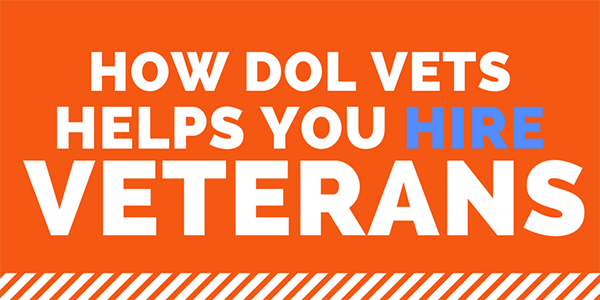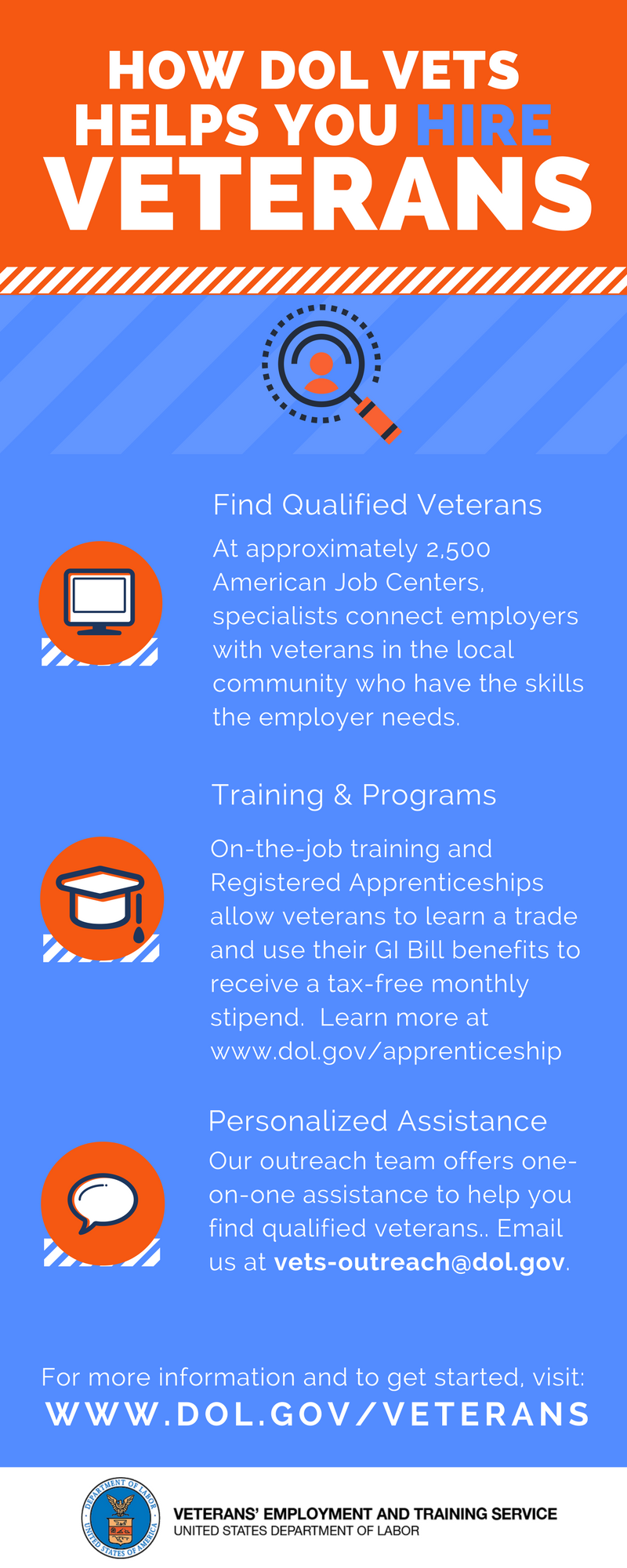The Labor Department’s Veterans’ Employment Training Services (VETS) focuses on four key areas to support our nation’s veterans: 1) preparing veterans for meaningful careers; 2) providing them with employment resources and expertise; 3) protecting their employment rights; and, 4) promoting the employment of veterans and related training opportunities to employers across the country.
The organization is committed to working with employers like you – those who know that hiring veterans is not only the right thing to do, but it’s good for business.
Veterans in the Workforce
There are nearly 10.5 million veterans in the workforce today with approximately 200,000 who transition from military service each year. Veterans in the workplace are notably more mature than most employers realize, with 66% over the age of 45 and only 15% under age 35.
Thanks to the collective efforts of businesses and organizations across America and an improved economy, the unemployment rate for veterans has fallen from a high of 9.9% in January 2011 to 4.3% in 2016 – consistently lower than the unemployment rate for non-veterans.
While there has been great improvement in veteran employment, we still have nearly 500,000 unemployed veterans who are seeking meaningful employment.
Smart Decisions
Hiring and retaining veterans is a good business decision. Research shows that veterans bring a higher level of dedication and professionalism, are more productive, and have higher retention rates – attributes that cut costs and increase the bottom line for employers.
A study published in November 2016 by the Center for a New American Security, “Onward and Upward: Understanding Veteran Retention and Performance in the Workforce” surveyed managers and found that they place a strong emphasis on the leadership qualities veterans bring to the workplace. Their research indicates that 90% of the managers surveyed say veterans are promoted faster, 68% say they perform better or much better than their non-veteran peers, and 75% say vets are easier to manage.
Top employers cite the attributes and characteristics of their veteran employees as demonstrating:
- Proven leadership/leadership readiness
- Mission focused, getting the job done
- Team players
- Quick learners and immediate contributors
- Strong work ethic
- Creative initiative
- Integrity
With nearly 2,500 American Job Centers (AJC) nationwide, and a team of regional and national employment outreach specialists, the DOL VETS are available to offer free, one-on-one assistance when looking to hire veterans. From helping to post jobs in the National Labor Exchange to finding qualified veterans in the local areas you want to hire from, DOL VETS can help tire dealers take the right steps.
Finding and Hiring Veterans
One of the first steps in hiring a veteran is to find qualified veterans in your local area that fit your unique hiring needs.
Their website, dol.gov/veterans, and local AJC are the best places to start when looking to hire veterans. Nearly 1 million last year alone used the free employment and training services at AJCs to find a job, over 13 million overall.
These AJCs offer employers free employment services that include:
- Providing workforce information;
- Writing job descriptions;
- Reviewing applicants resumes;
- Organizing job fairs;
- Providing places to conduct interviews;
- Pre-screening applicants;
- Assessing applicants skills;
- Referral of job-ready candidates.
Employment specialists at AJCs can also help you post your job openings for free through a state job bank, and nationally on the National Labor Exchange (NLx).
On-the-Job Training and Registered Apprenticeships
One of the best ways to retain employees is to offer on-the-job training, and opportunities for them to build their skills. Apprenticeships are on the rise in America and embody the job-driven training strategy that can help our economy grow.
For veterans, apprenticeships offer a great way to prepare for a new career. Apprenticeship programs allow veterans to learn a trade or skill through on-the-job training rather than attending formal classroom instruction. At the same time, veterans can use their GI Bill benefits to receive a tax-free monthly stipend that helps with housing and other monthly living expenses.
Employers may also be eligible to earn financial incentives to start a registered apprenticeship program of their own.
Learning about and/or getting help with developing an apprenticeship program is a free service provided by DOL VETS.
Personalized Assistance
Navigating the resources available to you when it comes to finding, hiring and training veterans can be confusing. The Department of Labor’s VETS has a team of Regional Veterans’ Employer Coordinators (RVECs) to connect people with federal, state and local resources, including on-the-job training and apprenticeship programs to help reduce employer costs and facilitate veterans’ employment.
Whether you need local hiring assistance or you’re ready to push a national hiring initiative, email them at [email protected]. You can also find out more information on the employer assistance program at
www.veterans.gov.
Mark Toal is a National Veterans’ Employment Outreach Manager for the U.S. Department of Labor















